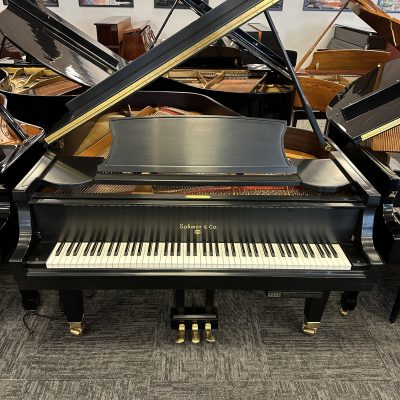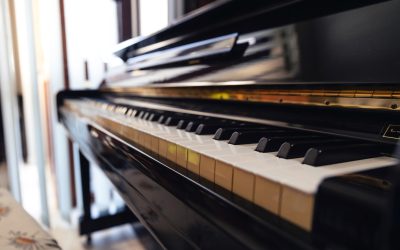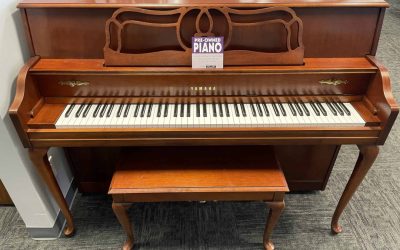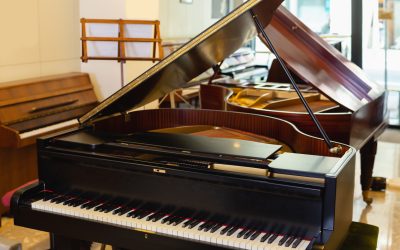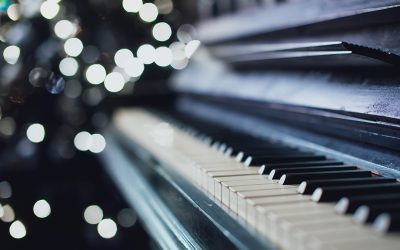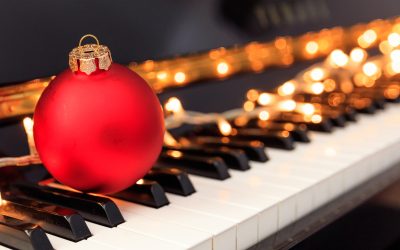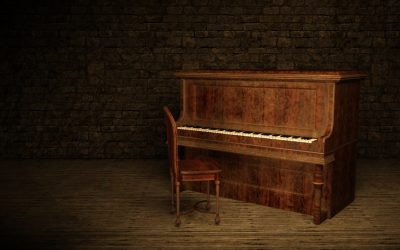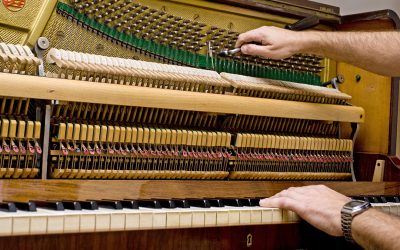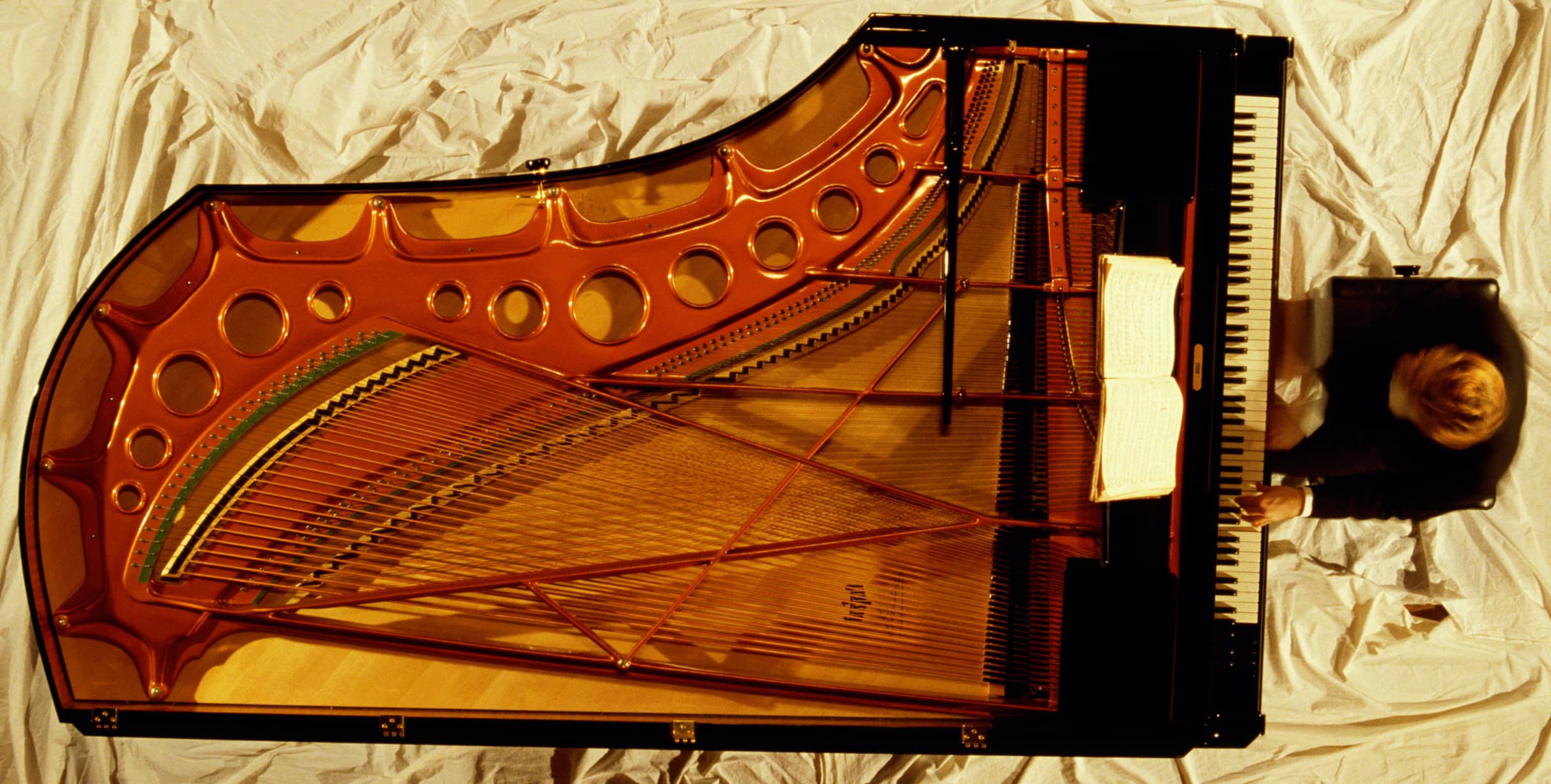
If you’re a piano player, can feel the magic of a grand piano as you play, your fingers moving across the keyboard with nuanced strokes that bring beautiful music that resounds through the instrument. Behind its elegant exterior lies a complex mechanism that translates the pianist’s touch into a symphony of sound. In this blog post, we’ll unravel how a grand piano works, from the key press to the room-filling music.
How a Grand Piano Works
A grand piano is a marvel of acoustics. The sound begins with the pressing of a key, which triggers a felt-covered hammer to strike tightly stretched strings. The force and speed of the hammer strike are influenced by the velocity with which the key is pressed. This dynamic range allows for the production of soft, mellow tones or loud, powerful crescendos. These strings vibrate, creating sound waves that resonate through the wooden soundboard, amplifying the tone. This interplay of physics and engineering allows pianists to produce a range of sounds, from gentle whispers to powerful crescendos.
1. The Key Mechanism
At the heart of the grand piano’s operation is the key mechanism. When a pianist presses a key, it sets off a series of events that ultimately produce sound. Each key is a lever, and as it is pressed, it lifts a hammer mechanism.
2. Hammer Action
The hammer action is a critical component in determining the quality of a piano’s sound. As the key is pressed, it causes the hammer to strike the strings. The precision of this mechanism ensures that each note can be played with distinct clarity and expression. Some piano brands have greater precision than others, making hammer action (or, simply, “action”) being one of the primary qualities an experience pianist will look for in a new or used piano.
Shop Used Grand Pianos
3. Strings
The strings are responsible for producing the actual sound. Grand pianos have strings of varying lengths and thicknesses, each corresponding to a specific pitch. The vibrations generated by the striking hammers travel through the strings and are then transferred to the soundboard.
4. The Soundboard
The soundboard is a large, thin wooden board positioned beneath the strings. Its role is to amplify and resonate the vibrations from the strings, enhancing the overall volume and richness of the sound. The soundboard is carefully crafted to ensure it vibrates freely and evenly across its surface.
5. Dampers and Sustain Pedal
To control the duration of each note, dampers are employed. When a key is released, the damper comes into contact with the string, stopping the vibration and ending the note. The sustain pedal, when pressed, lifts all the dampers simultaneously, allowing the strings to vibrate freely and creating a sustained sound.
6. Wooden Frame
The wooden frame of a grand piano is a crucial component. It provides the necessary support for the tension of the strings and contributes to the resonance of the instrument. The choice of wood and the construction of the frame are essential factors in determining the piano’s tonal quality.
7. Regulation and Tuning
Piano technicians perform regulation and tuning to ensure that the entire mechanism operates precisely. Regulation involves adjusting the action to achieve uniform response across all keys, while tuning ensures that each string produces the correct pitch.
What About That Large Metal Plate?
The metal part on the inside of a grand piano is called the “frame” or “plate.” This large, cast iron frame is crucial for a piano’s structure and sound. It supports the tension of the piano strings and maintains the piano’s structural integrity. The plate is also responsible for sustaining the immense string tension, which can be up to 20 tons in a concert grand piano. This component plays a key role in the piano’s ability to produce its characteristic sound and sustain long-term tuning stability.
The holes in a piano plate, also known as the cast iron frame, serve several important functions:
-
Reducing Weight: The cast iron plate is extremely heavy, and the holes help to reduce its overall weight without compromising its strength and structural integrity.
-
Acoustic Properties: The placement and size of these holes can influence the piano’s acoustic properties. They are designed to allow for optimal sound wave movement and resonance within the piano.
-
Aesthetic Design: In some pianos, the holes are also arranged in a way that contributes to the aesthetic design of the instrument.
Final Thoughts
A grand piano is not just a musical instrument; it’s a marvel of engineering and artistry. Understanding the intricate workings of its mechanism enhances our appreciation for the craftsmanship involved in creating these beautiful instruments. The next time you listen to the grandeur of a piano concerto, you can enjoy not only at the skill of the pianist but also at the mechanics that bring the music to life.
Shop Used Pianos
About the Author
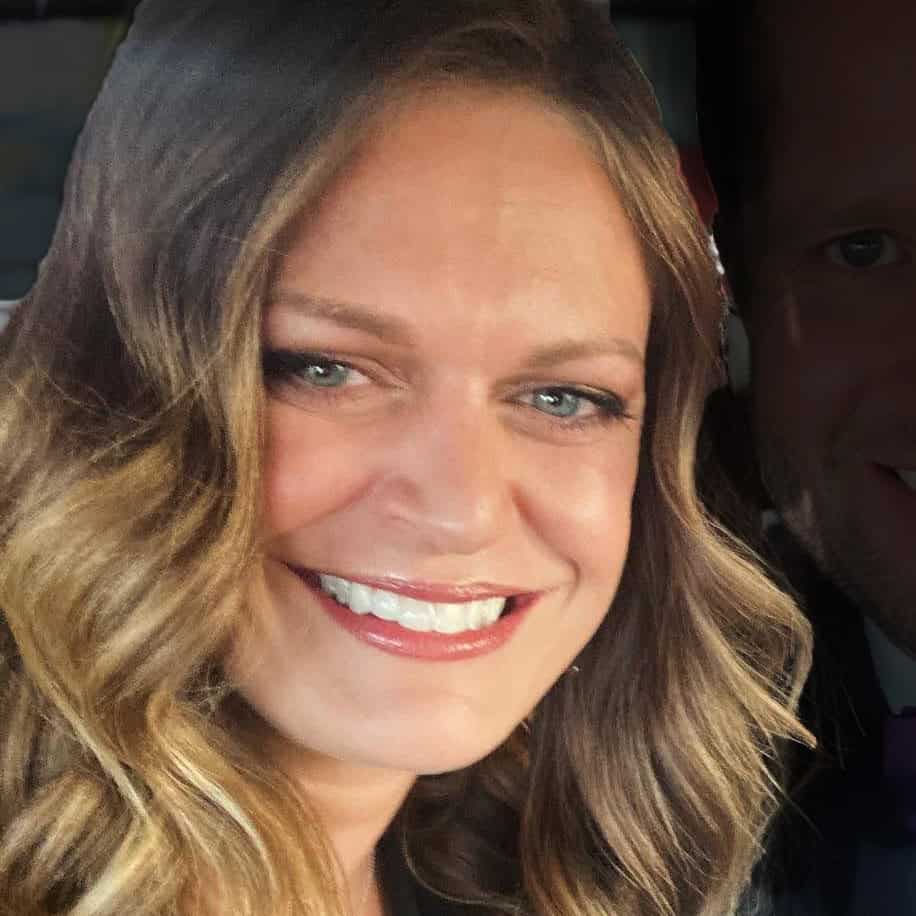
Mikelle Despain
Piano Insights Author
Mikelle is a classically trained pianist and former piano teacher who has been in the piano retail industry for over 20 years. Her dream piano is a Yamaha S5X. She currently provides expert insights for Piano Gallery to share information and advice for buying, playing, and enjoying the piano. When she's not writing or playing piano, she's spending time with her four kids, tending her vegetable garden, boondock camping, hiking, or cooking overly-extravagant meals for friends.
Further Reading...
Is Having a Piano in the Home Good for Kids?
We already know that there are several benefits to kids for learning to play the piano, but what about just having a piano in the home? For children who are still too young to play the piano or for those who have chosen to pursue other passions, there are still...
How to Encourage Piano Playing in Your Home
Every once in a while we encounter someone who would love to buy a new piano for their home–but is worried it won’t get played often enough to make the purchase worth it. In this article, we discuss some of our favorite tips for encouraging piano playing in your home....
How to Spot a Quality Piano: A Beginner’s Guide
If you’re looking to buy a piano, whether new or used, you may be wondering how to ensure your purchase is of good quality. After all, purchasing a piano can be a significant investment, depending on whether you’re purchasing a beginner piano or an advanced piano, and...
Used Yamaha Pianos: What to Know
Used Yamaha pianos are among the fastest-selling brands of used pianos. Because of their material and manufacturing quality as well as global brand recognition, Yamaha pianos are preferred by individuals looking for a used piano they can rely on. Yamaha Pianos Their...
Why Buy a Used Piano?
If you’re interested in purchasing a new piano, you may be considering the benefits of a used piano compared to a new piano. Used pianos can be a tricky purchase if you don’t know what you’re looking for, especially if you’re buying from a private party that may not...
Tips for Buying an Affordable Piano
What it usually looks like is a former piano player in a home that is in desperate need of a piano so they can reinvigorate their passion for the art. Or a family that is prioritizing the development of musical skills and the additional benefits children receive by...
Should I Buy a New or Used Piano?
When customers come into one of our piano stores, they're often unsure whether to buy a new or used piano. Should You Buy a New or Used Piano? Since pianos hold their value for a long time, a new acoustic piano, when cared for, can be an investment that will last your...
14 Favorite Christmas Piano Songs of All Time
Christmas music is perhaps the fastest way to evoke the spirit of Christmas in our homes and workplaces. Whether we’re children still learning the lyrics or adults filled with nostalgia, Christmas music is the source of warm, joyful emotions that move our hearts. Over...
What Are The 4 Types Of Upright Pianos
There are 4 different types of Upright Pianos in the world. If you are an expert in the world of pianos or just started playing, we are here to inform you of the different types of upright pianos, their purpose, and the best one out of the group. #1 The Spinet Piano ...
Mistakes to Avoid When Buying a Piano
Music makes the world go ‘round. Investing in instruments makes music and its creation an easily accessible part of daily life. Adding regular practice to your daily routine has so many benefits that extend into other aspects of life, like improving cognitive...
How Often do you Need to Tune a Piano?
A piano is an investment. Proper care of your investment, which includes things like dusting and polishing in addition to professional tuning, ensures the longevity of your piano and maintains the quality of sound it produces. One of the most common questions we are...
What to Look for in a Piano Teacher
Searching for a piano teacher is about so much more than cost and location. You want to choose a teacher who fits your learning style, teaches the type of music that interests you, and works well with your personality. Your (or your child's) piano teacher will have a...
